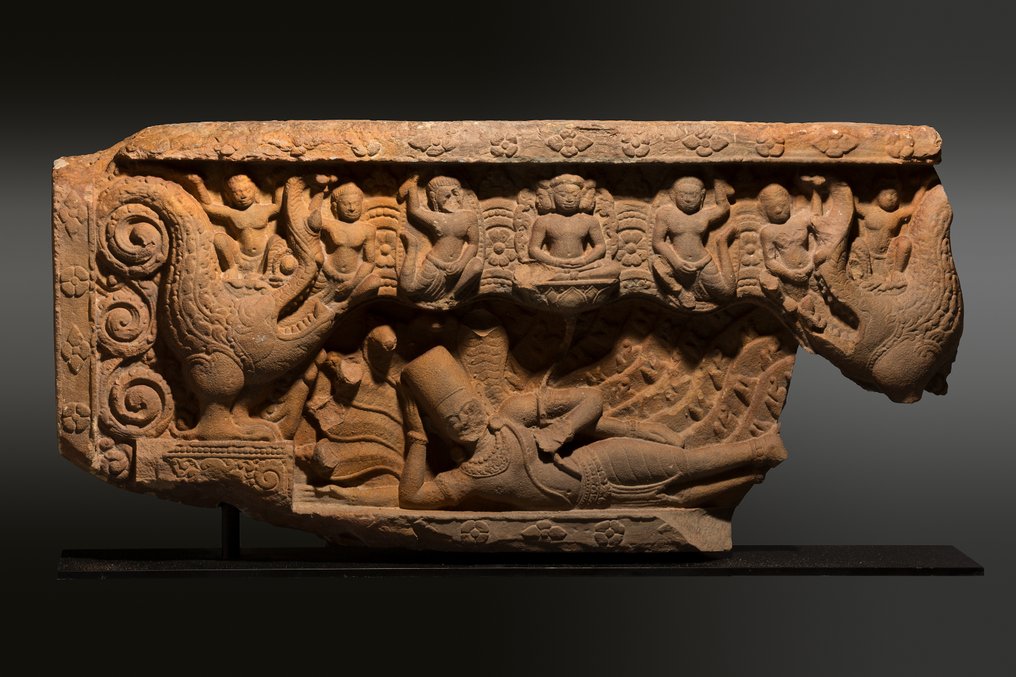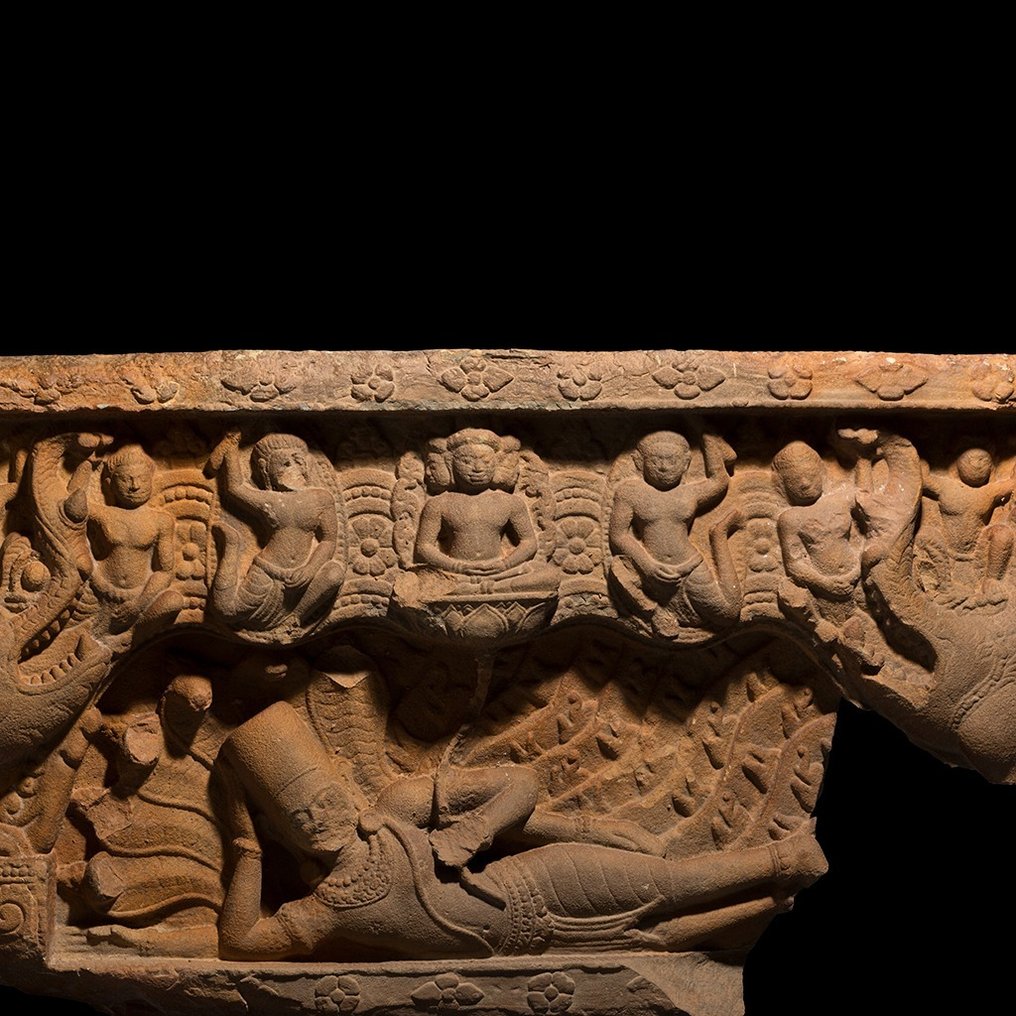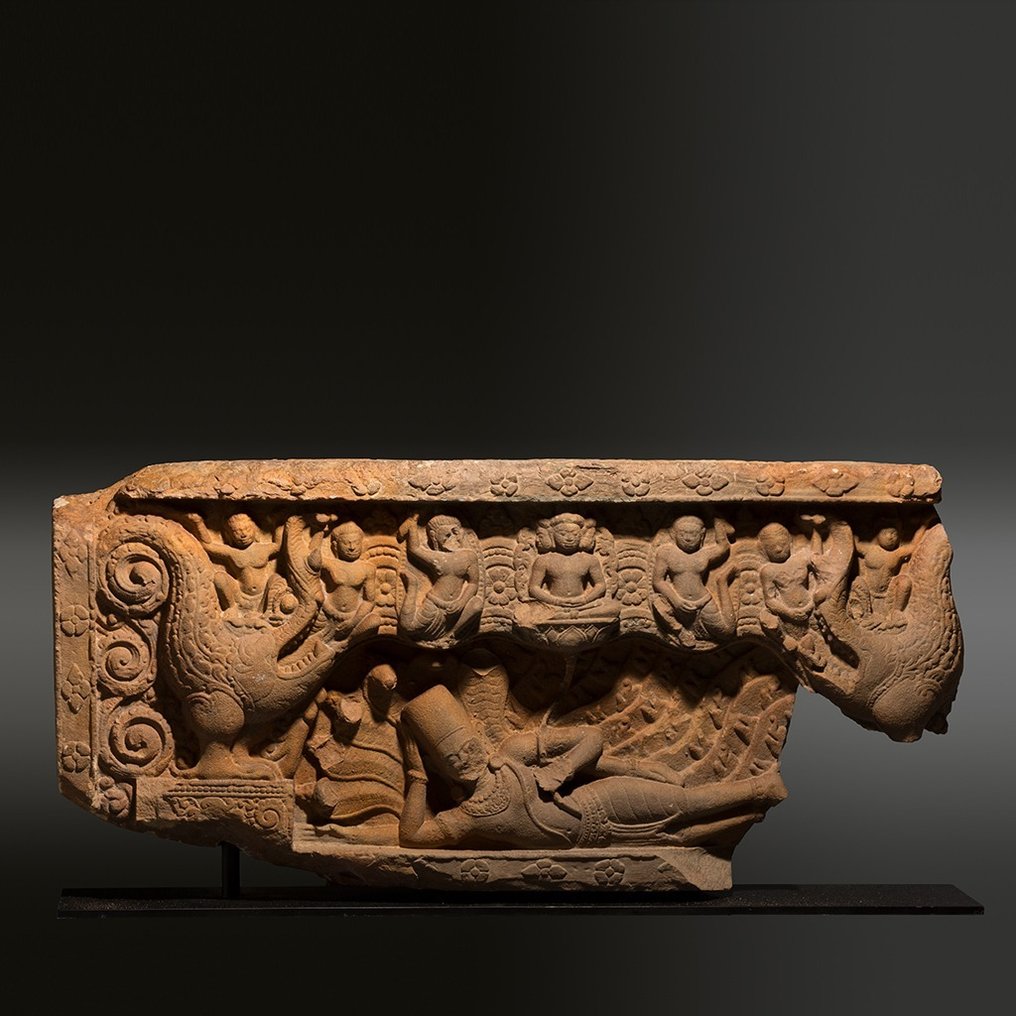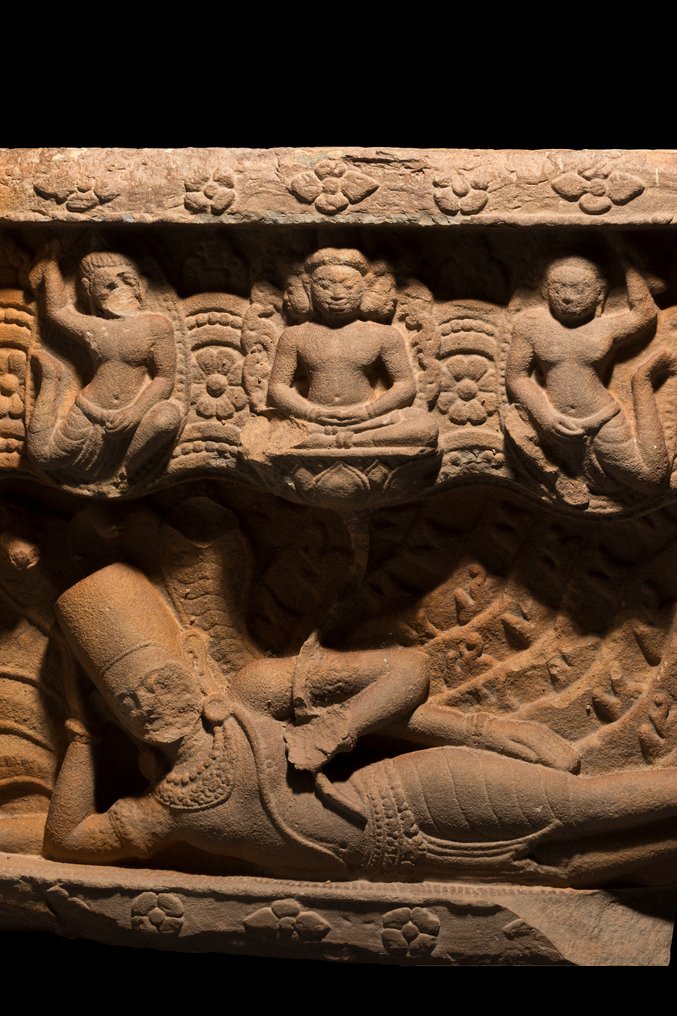Magnífica la entrega y el objeto. Perfecta la sonido del sibato
Se översättningPre-Angkor, Kambodja Sandsten Pre-Angkor, Kambodja Sandstensöverstycke med drömmen om Vishnu och Brahmas födelse. 108 cm L.
Nr 88174125





Lintel with the dream of Vishnu and the birth of Brahma
CULTURE: Pre-Angkor, Cambodia
PERIOD: Pre-Angkor period, end of 7th century - beginning of 8th century A.D.
MATERIAL: Sandstone
DIMENSIONS: 108 cm long and 51 cm high
PROVENANCE: Private collection, Asia, 1960.
CONSERVATION: Good condition, no restorations, except for the lack of the faces of some figures.
The chronological classification of Khmer monuments is essentially based on the study of architectural decoration. Following the work of Philippe Stern and Gilberte de Coral-Rémusat, who carried out a large number of studies, both through observations and detailed examinations, these works can be understood and classified. Pilasters and pediments, lintels and colonnades have evolved over the centuries at a variable rate, with some styles lasting a few decades and others, almost a century.
Lintels, when not reused from an earlier building, are arguably the most valuable chronological markers: each period in ancient Cambodian art is, in fact, remarkably different from earlier and later periods. The change from one style to another may occur gradually, as in the case of sculpture, in which case one speaks of evolution, or more radically, in which case one speaks of mutation.
The beautiful brick monuments belonging to the northern and southern groups of the ancient religious city of Sambor Prei Kuk are considered to be among the oldest Khmer temples still in existence (first half of the 7th century). Within this brick architecture, the door frames, lintels and columns were made of sandstone. They were clearly used to strengthen the buildings and, in some cases, have been the only elements that have been preserved.
In its composition, the more linear lintels are generally organized around a horizontal axis that marks the upper third of the area. It takes the form of a poly-lobed arch with vegetal motifs and beadwork, probably a stone copy of a wooden element.
The central scene that decorates this lintel, made in bas-relief, represents the dream of Vishnu and the birth of Brahma. Four-armed Vishnu is shown reclining on the mythical Naga, Ananta, whose six heads unfold to protect him. The god Brahma sits on an open lotus flower with a stem growing out of Vishnu's navel. He supports and holds the stem with his left hand. Four flying apsaras, two on each side, each wielding a mace with the outer arm, flank the image of Brahma. On each side of the central Vishnu scene is depicted a large makara with bird's feet and a three-spiraled tail, similar to the makaras on the 7th-century Prasat Dap lintel. A small figure emerges from the open jaws of each makara, like those on a 7th century lintel from Sambor Prei Kuk. By comparison with other lintels of similar iconography, one preserved in a U.S. collection and another at Tuol Ang in Kompong Speu, it can be deduced that tiny aquatic figures, such as the makara and the fish, would be shown emerging from raised, undulating panels representing water, just above the legs of Vishnu.
The dream of Vishnu, known as Vishnu Anantasayana, and the birth of Brahma were popular themes, frequently depicted on Khmer lintels during the 7th and early 8th centuries. The Vishnu in the present lintel wears a linked sampot can kpin, breastplate and belt, similar to those worn by the Vishnu image on the 7th century lintel of Tuol Baset. The belt is also similar to that worn by the Kimbell Museum Harihara (n.18). Vishnu is also adorned with bracelets, anklets, round earrings, and a sacred rope running from the left shoulder across his body. He wears a miter on his head that appears to be combined with a diadem.
The image of Vishnu Anantasayana was first depicted in India during the 5th century in Udayageri Cave 13. The pose of the Udayageri Vishnu is not the same as that of the images of Vishnu Anantasayana in Khmer sacred sculptures when it was first depicted in the 7th century. The basic image of Vishnu Anantasayana followed by Khmer artisans was not formulated in ancient India until the 6th century. A late Gupta period example at Deogarh in which Vishnu is adorned with a breastplate, belt, earrings and diadem, shows the same type of ornaments used by Vishnu in this lintel. A 7th-8th century gilt-bronze Srivijaya ornament found at Muang Pra Wiang, Nakhon Si Thammarat, in mainland Thailand, depicts a makara that is very similar to the one depicted here.
BIBLIOGRAPHY:
- Sculpture of Angkor and Ancient Cambodia: Millennium of Glory. Thames & Hudson. 1997. pp. 166-167.
- BUNKER, E. y LATCHFORD, D. Adoration and Glory. The Golden Age of Khmer Art. Art Media Resources Ltd. 2003. pp. 84 – 85.
- DAGENS, B. y DALSHEIMER, N. Les collections du musée national de Phnom Penh, l’art du Cambodge ancient. École Française d’Extreme-Orient. 2001. pp. 183, 184, 187, 192, 193.
Notes:
- The piece includes authenticity certificate.
- The piece includes Spanish Export License (Passport for European Union). NOT TAXES.
- According to Spanish legislation, items sent outside the European Union are subject to export taxes and will be added to the invoice, at the buyer's expense. These export fees are fixed on the final auction price and the tax rate is not applied directly on the total value of the item to be exported, but rather the different percentages by sections are applied to it:
- Up to 6,000 euros: 5%.
- From 6.001 to 60.000 euros: 10%.
This export permit application process can take between 1-2 months maximum.
- The seller guarantees that he acquired this piece according to all national and international laws related to the ownership of cultural property. Provenance statement seen by Catawiki.
#MasterpiecesW39
Säljarens berättelse
Lintel with the dream of Vishnu and the birth of Brahma
CULTURE: Pre-Angkor, Cambodia
PERIOD: Pre-Angkor period, end of 7th century - beginning of 8th century A.D.
MATERIAL: Sandstone
DIMENSIONS: 108 cm long and 51 cm high
PROVENANCE: Private collection, Asia, 1960.
CONSERVATION: Good condition, no restorations, except for the lack of the faces of some figures.
The chronological classification of Khmer monuments is essentially based on the study of architectural decoration. Following the work of Philippe Stern and Gilberte de Coral-Rémusat, who carried out a large number of studies, both through observations and detailed examinations, these works can be understood and classified. Pilasters and pediments, lintels and colonnades have evolved over the centuries at a variable rate, with some styles lasting a few decades and others, almost a century.
Lintels, when not reused from an earlier building, are arguably the most valuable chronological markers: each period in ancient Cambodian art is, in fact, remarkably different from earlier and later periods. The change from one style to another may occur gradually, as in the case of sculpture, in which case one speaks of evolution, or more radically, in which case one speaks of mutation.
The beautiful brick monuments belonging to the northern and southern groups of the ancient religious city of Sambor Prei Kuk are considered to be among the oldest Khmer temples still in existence (first half of the 7th century). Within this brick architecture, the door frames, lintels and columns were made of sandstone. They were clearly used to strengthen the buildings and, in some cases, have been the only elements that have been preserved.
In its composition, the more linear lintels are generally organized around a horizontal axis that marks the upper third of the area. It takes the form of a poly-lobed arch with vegetal motifs and beadwork, probably a stone copy of a wooden element.
The central scene that decorates this lintel, made in bas-relief, represents the dream of Vishnu and the birth of Brahma. Four-armed Vishnu is shown reclining on the mythical Naga, Ananta, whose six heads unfold to protect him. The god Brahma sits on an open lotus flower with a stem growing out of Vishnu's navel. He supports and holds the stem with his left hand. Four flying apsaras, two on each side, each wielding a mace with the outer arm, flank the image of Brahma. On each side of the central Vishnu scene is depicted a large makara with bird's feet and a three-spiraled tail, similar to the makaras on the 7th-century Prasat Dap lintel. A small figure emerges from the open jaws of each makara, like those on a 7th century lintel from Sambor Prei Kuk. By comparison with other lintels of similar iconography, one preserved in a U.S. collection and another at Tuol Ang in Kompong Speu, it can be deduced that tiny aquatic figures, such as the makara and the fish, would be shown emerging from raised, undulating panels representing water, just above the legs of Vishnu.
The dream of Vishnu, known as Vishnu Anantasayana, and the birth of Brahma were popular themes, frequently depicted on Khmer lintels during the 7th and early 8th centuries. The Vishnu in the present lintel wears a linked sampot can kpin, breastplate and belt, similar to those worn by the Vishnu image on the 7th century lintel of Tuol Baset. The belt is also similar to that worn by the Kimbell Museum Harihara (n.18). Vishnu is also adorned with bracelets, anklets, round earrings, and a sacred rope running from the left shoulder across his body. He wears a miter on his head that appears to be combined with a diadem.
The image of Vishnu Anantasayana was first depicted in India during the 5th century in Udayageri Cave 13. The pose of the Udayageri Vishnu is not the same as that of the images of Vishnu Anantasayana in Khmer sacred sculptures when it was first depicted in the 7th century. The basic image of Vishnu Anantasayana followed by Khmer artisans was not formulated in ancient India until the 6th century. A late Gupta period example at Deogarh in which Vishnu is adorned with a breastplate, belt, earrings and diadem, shows the same type of ornaments used by Vishnu in this lintel. A 7th-8th century gilt-bronze Srivijaya ornament found at Muang Pra Wiang, Nakhon Si Thammarat, in mainland Thailand, depicts a makara that is very similar to the one depicted here.
BIBLIOGRAPHY:
- Sculpture of Angkor and Ancient Cambodia: Millennium of Glory. Thames & Hudson. 1997. pp. 166-167.
- BUNKER, E. y LATCHFORD, D. Adoration and Glory. The Golden Age of Khmer Art. Art Media Resources Ltd. 2003. pp. 84 – 85.
- DAGENS, B. y DALSHEIMER, N. Les collections du musée national de Phnom Penh, l’art du Cambodge ancient. École Française d’Extreme-Orient. 2001. pp. 183, 184, 187, 192, 193.
Notes:
- The piece includes authenticity certificate.
- The piece includes Spanish Export License (Passport for European Union). NOT TAXES.
- According to Spanish legislation, items sent outside the European Union are subject to export taxes and will be added to the invoice, at the buyer's expense. These export fees are fixed on the final auction price and the tax rate is not applied directly on the total value of the item to be exported, but rather the different percentages by sections are applied to it:
- Up to 6,000 euros: 5%.
- From 6.001 to 60.000 euros: 10%.
This export permit application process can take between 1-2 months maximum.
- The seller guarantees that he acquired this piece according to all national and international laws related to the ownership of cultural property. Provenance statement seen by Catawiki.
#MasterpiecesW39
Säljarens berättelse
- 825
- 10
- 1
very well packed with all the documents included, thnks
Se översättningGreat object. Really beautiful. Quick delivery. Excellent.
Se översättningSuperbe objet, Service d'Arqueologia Ancient Art excellent et rapide. Jaume Bagot toujours parfait .
Se översättningTodo perfecto gracias
Se översättningNice item all ok A+++
Se översättningThank you for this Oinochoe, one question: did you as promised read my post!
Se översättningVery cooperative in every aspect of the transaction.
Se översättningAlways a great pleasure!
Se översättningFine quality, good service. Thanks.
Se översättningMuy amables, muy bien todo. Gracias
Se översättningAlles bestens
Se översättningexactly as described and shipped safely and punctually.
Se översättningschnelle Lieferung sehr sichere Verpackung alles bestens
Se översättningtres bel objet je le recherchai depuis longtemps envoi rapide et protégé je pense qu'il y aura d'autres achats avec ce vendeur merci +++++++
Se översättningEinfach nur toll
Se översättningTodo perfecto
Se översättningottimo
Se översättningperfetto
Se översättningtop oggetto bellissimo grazie 💯💯💯💯💯💯 :-)
Se översättningI bought this beautiful artifact together with artifact from Mr. Bagot but although it is clearly stated on his shipping page that when purchasing multiple artifacts i paid the double package costs
Se översättningI bought this beautiful artifact together with artifact from Mr. Bagot but although it is clearly stated on his shipping page that when purchasing multiple artifacts i paid the double package costs
Se översättningBel objet, bien emballé. Parfait.
Se översättningwonderful faiece and very fast shipping.thanks a lot
Se översättningJ Bagot es un profesional excelente. Sus artículos son de gran calidad, se incluye la documentación necesaria y el embalaje se realiza con esmero. Le recomiendo encarecidamente.
Se översättning- 825
- 10
- 1
Magnífica la entrega y el objeto. Perfecta la sonido del sibato
Se översättningAnsvarsfriskrivning
Säljaren garanterar och kan bevisa att objektet införskaffats på lagligt sätt. Säljaren har informerats av Catawiki att de måste lämna den dokumentation som är obligatorisk enligt lagar och regler i det land de är bosatta. Säljaren garanterar och har rätt att sälja/exportera detta objekt. Säljaren tillhandahåller all information om härkomst som är känd om objektet till köparen. Säljaren säkerställer att alla nödvändiga tillstånd är/kommer att bli ordnade. Säljaren informerar köparen omedelbart om eventuella förseningar gällande att anskaffa sådana tillstånd.
Säljaren garanterar och kan bevisa att objektet införskaffats på lagligt sätt. Säljaren har informerats av Catawiki att de måste lämna den dokumentation som är obligatorisk enligt lagar och regler i det land de är bosatta. Säljaren garanterar och har rätt att sälja/exportera detta objekt. Säljaren tillhandahåller all information om härkomst som är känd om objektet till köparen. Säljaren säkerställer att alla nödvändiga tillstånd är/kommer att bli ordnade. Säljaren informerar köparen omedelbart om eventuella förseningar gällande att anskaffa sådana tillstånd.









